Olympus PEN E-PM1 Review
Olympus PEN E-PM1 Introduction
The Olympus PEN E-PM1, also known as the PEN Mini, is an entry-level Micro Four-Thirds SLD from Olympus. This digital camera is built around a 12 megapixels Four-Thirds sensor with a maximum ISO of 12800, unlimited 4.1 FPS full-resolution drive and 1080p HD video capability. It features built-in image stabilization and a hot-shoe with accessory port which supports an optional add-on EVF. The E-PM1 includes a small flash unit which attaches to the hot-shoe.
The E-PM1 distinguishes itself by having sophisticated video features. These include Program, Aperture-Priority, Shutter-Priority and Manual exposure as well as Art Filters. It offers plenty of video focus modes like continuous autofocus (AF-C), subject-tracking and direct manual-focus (DMF). It can record stereo sound via a built-in microphone or an external one which connects the the hot-shoe's accessory port.
This digital camera review analyses the ergonomics, usability, performance and image quality of the Olympus PEN E-PM1.
Olympus PEN E-PM1 Features
Sensor
- 12 Megapixels CMOS Four-Thirds sensor
- Micro Four-Thirds lens mount
- Sensor-Shift image stabilization
- Built-in ultra-sonic dust-reduction
Exposure
- ISO 200 to 12800 sensitivity, 1 or 1/3 EV steps
- Auto ISO, customizable limit from 200 to 12800
- ISO Bracketing, 3 frames, maximum 1 EV increments
- 1/4000-60s Shutter-speeds, Bulb up to 30 minutes, 1/2 or 1/3 EV steps
- PASM Exposure modes
- Program-Shift in P mode
- Exposure-Compensation, ±3, 1/3 or 1/2 EV increments
- Exposure-Shift, ±1, 1/6 EV increments
- Multi-Segment, Center-Weighed, Spot, Shadow Spot and Highlight Spot metering
- Auto-Exposure Bracketing, 3, 5 or 7 frames, maximum 1 EV steps except 1/2 EV for 7 frames
- Flash Bracketing, 3 frames, maximum 1 EV increments
- Flash-Compensation, ±3, 1/3 or 1/2 EV increments
- Auto, Redeye, Forced, Off, Slow-Sync+Redeye, Slow-Sync, Rear-Sync and Manual flash modes
- Manual flash power between full and 1/64th power
- Remote-Control flash
Image Parameters
- Automatic, 7 presetsSunny, Shade, Cloudy, Incandescent, Fluorescent, Underwater, Flash, kelvin and custom white-balance
- White-balance fine-tuning along 2 axis in 15 steps
- Digital white-balance preview
- White-balance bracketing, 1 or 2 axis, 3 frames along each axis, 3 step sizes
- Optional One-Touch custom white-balance
- Optional and automatic long shutter noise-reduction
- Optional high-ISO noise-reduction, 3 levels
- 5 Color and 1 B&W Picture Modes
- Adjustable contrast, sharpness, saturation, 5 steps each
- Adjustable gradation, automatic or 3 levels
- Adjustable tone curve, 15 steps for highlights and 15 steps of shadows
- sRGB or Adobe RGB color space
Focus
- Single-shot (AF-S), Continuous (AF-C), Direct Manual-Focus (DMF) or Tracking autofocus
- Manual-focus (MF), optional display magnification up to 14X
- 35-area AF system, automatic or manual point-selection
- Face-Priority toggle
- Optional bulb focusing
- Optionally reset lens focus to infinity
- Controllable focus-ring direction
- Optional AF-Assist lamp
Drive
- 4 FPS Continuous Drive, 5 FPS with Stabilization disabled
- Buffer for unlimited JPEG images or 10 RAW files
- Multiple-Exposure, 2 frames, optional automatic gain and composition overlay
- Self-timer, 2s or 12s
Video
- 1920x1080 @ 30 FPS Video using AVCHD codec
- 1280x720 @ 60 FPS Video using MPEG-4 codec
- Program, Aperture-Priority, Shutter-Priority and Manual video exposure
- Automatic and Art-Filter video modes
- Optional stereo sound with built-in microphone
- Optional external stereo microphone via a hot-shoe accessory port
Display & Viewfinder
- 3" LCD, 460K Pixels
- Depth-Of-Field Preview
- Optional Live-Histogram
- Optional guidelines, 4 types
- Optional blinking highlight
- Adjustable brightness, 15 steps
- Adjustable color, 15 steps, 1 axis
- Optional 0.2" EVF, 1.4 megapixels
Output Processing
- 4:3 Native aspect ratio
- 3:2, 16:9, 1:1 and 3:4 cropped aspect ratios
- 12, 8, 5, 3, 2 and 1.2 megapixels modes
- JPEG, RAW, RAW+JPEG capture
- 4 JPEG Compression levels
- Optional vignetting correction
Connectivity
- Hot-Shoe with Accessory port
- HDMI (1080i) output
- A/V (NTSC / PAL) output
- USB 2.0 connectivity
Misc
- Lens stabilization control, 3 modesBi-Directional, Horizontal, Vertical
- SDXC memory
- Lithium-Ion battery
- Custom DPI settings
- Custom Copyright data
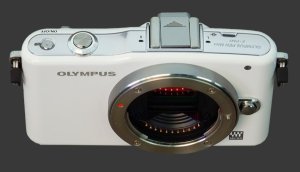
Olympus PEN E-PM1 Usability - How easy is it to use?
A quick look at the E-PM1 feature list above shows that this digital cameras has considerably more features that was is expected from an entry-level model. The Olympus approach to entry-level models is to give them very few external controls but to keep a high level of customization. Advanced features that only require firmware are also implemented such as bracketing, multiple exposures, tone-curve control and DOF preview.
This compact SLD shows excellent build quality for its class. The smooth metallic body gives the PEN E-PM1 a more luxurious feel than its price-tag would suggest. Along with the quality build, Olympus fitted the E-PM1 with the same 12 megapixels sensor and fast processor as its higher end PEN models. These are features which beginners can appreciate rather than having more complex controls.
The minimal size of the Olympus PEN E-PM1 is an attractive feature until you hold one. The flat front makes it difficult to grip securely and the narrow body with to shutter-release means the neck-strap eyelets dig into your hand each time a shot is taken.
At the top of the camera, there is a standard two-stage shutter-release, a small recessed power button and a hot-shoe between a pair of microphones to record stereo sound. The shutter operated smoothly with a good amount of travel to the halfway point and a short release after that. The small power button is responsive but not easy to activate unintentionally. Since the E-PM1 does not have a built-in flash, a small add-on one is provided.
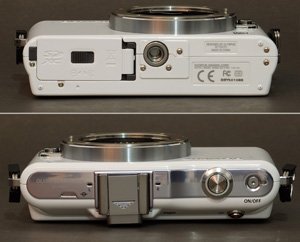 The hot-shoe is paired with a proprietary accessory-port which supports an optional 0.2" EVF with 1.4 MP among other accessories such as an external stereo microphone. Given there is only one such port, this means that only one add-on can be used at a time.
The hot-shoe is paired with a proprietary accessory-port which supports an optional 0.2" EVF with 1.4 MP among other accessories such as an external stereo microphone. Given there is only one such port, this means that only one add-on can be used at a time.
The bottom of this camera has a metal tripod mount centered relative to the camera which is good for balance but not for panoramas. There is a single metal door which covers the combined batter and memory card compartment. Since it is right next to the tripod socket, neither battery nor memory can be changed while on a tripod or mounted on a quick release plate.
The remaining few controls are on the back of the camera to the right of the wide-aspect ratio (16:9) 3" LCD screen with 460K pixels. The screen is very sharp and - combined with manual focus magnification - makes it extremely easy to confirm focus. Visibility is decent but the contrast is lower than most modern cameras. There is an effective any reflection coating which prevents the display from washing out quickly.
One common problem about modern cameras is the poor accuracy of their preview but as one of the pioneers of Live-View, Olympus actually gets it mostly right. The E-PM1 shows a good Exposure-Priority preview in both Program and Manual mode but not in Aperture-Priority or Shutter-Priority mode. The Live-Histogram reflects the same problem showing a good approximation of exposure in P and M mode but not in A or S.
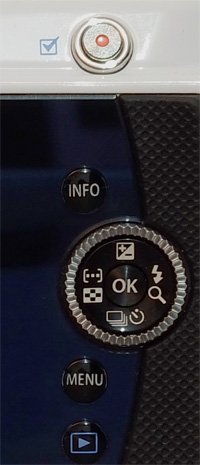 The top rear control is the video recording button. Luckily, this button can be customized to access much more useful functions: AE-L/AF-L, DOF Preview, One-Touch Custom White-Balance, Focus Point Home, Manual Focus, RAW, Test Picture, Backlit LCD, Underwater Mode, Live Guide, 2X Digital Zoom, Focus-Aid Magnification and 4 custom modes. The AE-L/AF-L function can be customized further using the Setup menu. Picking the right function here is a tough choice as AE-L / AF-L and DOF Preview cannot be activated any other way.
The top rear control is the video recording button. Luckily, this button can be customized to access much more useful functions: AE-L/AF-L, DOF Preview, One-Touch Custom White-Balance, Focus Point Home, Manual Focus, RAW, Test Picture, Backlit LCD, Underwater Mode, Live Guide, 2X Digital Zoom, Focus-Aid Magnification and 4 custom modes. The AE-L/AF-L function can be customized further using the Setup menu. Picking the right function here is a tough choice as AE-L / AF-L and DOF Preview cannot be activated any other way.
Down from the Video Record button are the Info, Menu and Playback buttons with a combined 4-way controller and dial in between. These buttons almost work as usual:
- Info: Usually cycles between various display modes in both Capture and Playback modes. An option in the Setup menu controls which mode gets included in each cycle. After pressing the Up direction of the 4-way controller, the Info button cycles between EC, Highlight Tone-Curve and Shadow Tone-Curve.
- Menu: This button brings up a selecting screen for Exposure Modes and the actual menu system. The dial, left or right direction can select one of: Art Filters, iAuto, Scene, Movie, PASM or Setup. A specific mode among PASM is then selected with the up or down directions. This makes changing modes and camera settings slower than on most cameras.
- Playback: Works just as usual. Press to enter and exit playback mode. The E-PM1 is also shooting priority, so a half press of the shutter exists Playback mode as well.
There is a lot going on with the 4-way controller which is customizable. The central OK button can bring up different controls, including the most useful one which is called SCP for Super Control Panel. The SCP gives access to plenty of camera settings using an interactive control panel. These settings thankfully include ISO, White-Balance with Fine-Tuning, Drive Mode, Flash Mode, Focus Mode, Flash-Compensation, Metering and Image Stabilization plus some less common settings like Picture Mode, Saturation, Contrast, Sharpness, Tone-Curve, Image Quality, Face-Priority and Color-Space.
Each direction of the 4-way controller is assigned a function:
- Up is for Exposure-Compensation.
- Right is for Flash Mode. This can be replaced by ISO and WB among other not so useful settings.
- Down is for Drive Mode. This can be replaced by WB and Underwater mode among other settings.
- Left is for selecting the focus point. Pressing OK returns to normal operations afterwards.
The Olympus PEN E-PM1 only has a single control-dial, which is normal for an entry-level camera. This is the rather thin dial which surrounds the 4-way controller. It rotates easily with soft well-spaced detents. While not the greatest, it works reasonably well.
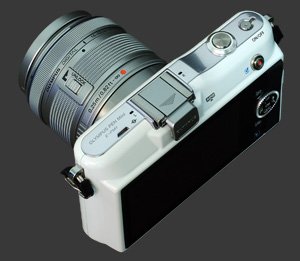
While this SLD is quite capable, its advanced features require too many button presses and trips through the oddly organized menu system, making it unsuitable for advanced users. Beginners though may feel more comfortable without too many buttons to confuse them. Those who like to carefully control the camera should look to the Olympus PEN E-P3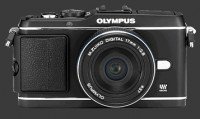
Olympus PEN E-P3 instead which features plenty of controls and dual control-dials.
Olympus PEN E-PM1 Performance - How well does it take pictures?
Performance starts with image quality, which is the criteria used as the foundation of our digital camera ratings. Ergonomic issues may get in the way, but in the end, image quality counts the most. For an ILC, image quality greatly depends on the lens used. While color, noise, exposure and dynamic-range are properties of a camera, distortion, vignetting and chromatic aberrations are properties of the lens. Sharpness and contrast depend on the weakest link. That is, a camera cannot capture more details than a lens lets through. Conversely, it is quite possible for a lens to transmit more details than a sensor can capture.
Image Noise & Details
The Olympus PEN E-PM1 shows good image quality with relatively low image noise up to ISO 800. Noise is easily noticeable at ISO 1600 which remain usable for medium sized prints. At ISO 3200, noise eats up more details e and all fine details disappear. At this point, only small grainy prints are possible. ISO 6400 remains barely usable but the maximum sensitivity of 12800 is extremely noisy and is best avoided.
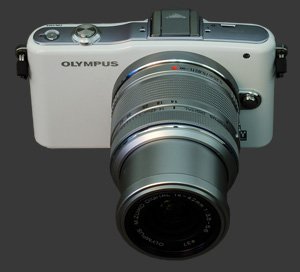 One may notice that Olympus SLDs remain at 12 megapixels since their original E-P1 and the E-PM1 performs similarly but slightly behind the E-P3 which was launched at the same time as the E-PM1. This is better explained by different processing engines rather than sensors. While this is a good performance, one should note that the image quality gap between Four-Thirds and APS-C sensor cameras is widening.
One may notice that Olympus SLDs remain at 12 megapixels since their original E-P1 and the E-PM1 performs similarly but slightly behind the E-P3 which was launched at the same time as the E-PM1. This is better explained by different processing engines rather than sensors. While this is a good performance, one should note that the image quality gap between Four-Thirds and APS-C sensor cameras is widening.
There are 3 levels of noise-reduction available. Olympus improved the performance of their noise-reduction algorithms, making them less destructive than before. Particularly, the Low setting is gentle enough to be used permanently. Sharpening has also improved and can now be boosted to +1 with barely any visible artifacts.
Color & White Balance
The E-PM1 struggles with color accuracy. There are plenty of Picture Modes but none produce colors resembling reality across the spectrum. Natural and Portrait both come close but show excessive amounts of red component. All the while, certain colors appear under-saturated, so shifting saturation improves some while making others worse.
Automatic While-Balance performance is far from perfect. While it can give really good results under a variety of conditions, the AWB system fluctuates widely, even under relatively static conditions. This suggests that it is based on a excessively small sample of the scene. Regardless of the cause, the E-PM1 struggles more than most modern cameras when it comes to AWB. Custom White-Balance on the other hand works just right and extremely easy to use with the One-Touch WB function assigned to the Video-Record button.
Exposure
This digital camera has a good multi-segment metering system. It is very conservative and overexposes only when there are rather small bright highlights. This means it requires more positive exposure-compensation than most. Low contrast scenes tend to come out quite dark since it unfortunately prefers exposing to the left than to the right. Still, contrast in not lost in those cases, only nuances within shadow areas, so brightening such an image is likely to produce banding.
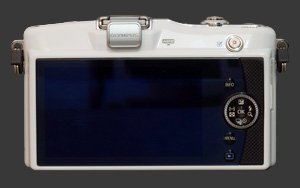
It is important to know that the LCD usually blocks up in shadow areas due to its limited contrast range. When in doubt, check Playback histogram which is available as Luminance or RGBL, just press the Info button to cycle through the various views. The same happens when adjusting the highlight tone-curve. Differences are not seen on the LCD but the image is in fact captured differently. Changes to the shadow tone-curve are much easier to see.
Auto Focus
The PEN E-PM1 has a reasonably fast contrast-detect autofocus system. This is by far the most improved aspect compared to previous generations. This model locks focus quickly and accurately. Even in moderately low light, focus rarely takes more than ½s. Often, and particularly when light-levels are good, the E-PM1 locks focus in about ¼s. It does happen that things take longer, particularly at close range, up to 1s before giving up.
With most Micro Four-Thirds lenses, focus is done via a fly-by-wire ring around the lens-barrel. The Olympus E-PM1 follows well with no perceptible lag. In DMF mode, a slight turn of the focus-ring shift into manual focus. Because the ring is fly-by-wire, this camera can reverse the direction for focusing except for those few lenses with a mechanical focus-ring.
Speed
The E-PM1 is a rather responsive digital camera. It is clear that Olympus put a lot of work into improving the speed of this SLD and with reason. These cameras still show a performance gap compared to DSLRs, the gap is closing in terms of speed. This digital camera responds to all buttons and dials instantly. The following measurements characterize its performance:
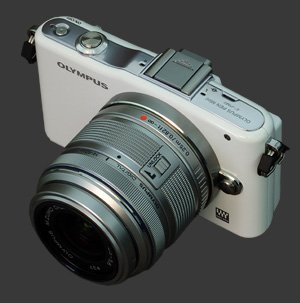
- Power-On: 1½ seconds.
- Power-On to First-Shot: 2 seconds.
- Autofocus: 1/3s on average, rarely more than ½s.
- Shutter-lag: Nearly instant with about 1s blackout.
- Shot-to-shot: 2s with AF, 1½s in MF mode.
- Playback: Under ½s to enter, Instant exit.
- Power-Off: Under 1 second.
- Video: ¼s to to start, instant stopping.
With numbers like this, the Olympus E-PM1 puts in a respectable performance on all fronts except shot-to-shot speeds. The black-out particularly makes it difficult to follow action, but for general use this camera performs well. The autofocus speed is exemplary and really shows that Contrast-Detect is becoming much more usable than at the dawn of SLDs.
These are awesome numbers for video. The minor start delay occurs while the E-PM1 oddly adjusts the angle-of-view and starts recording. While both continuous and tracking AF work quickly during video capture, the back-and-forth lens movement required by Contrast-Detection is still occasionally noticeable. Plus, like all autofocus system, the camera may incorrectly switch focus off the main subject, so it is best to use MF for video.
The Olympus PEN E-PM1 is powered by a proprietary Lithium-Ion battery which provides 330-shots per charge with 50% flash use. This is below average among SLDs yet should be enough for a day of shooting.
Olympus PEN E-PM1 Conclusion
The Olympus PEN E-PM1, called PEN Mini in some places, is one of the smallest and lightest SLDs available. With its relatively large sensor, it manages to deliver high quality images in a compact form-factor along with a speedy autofocus performance. Combined with the compact size of Micro Four-Thirds lenses, this camera can be taken places without much hassle.
This SLD gives a good all-around performance and has more advanced video capabilities, including manual controls, than one would expect from an entry-level model. Although the preview framing is not entirely accurate, the E-PMP1 is much better than most modern cameras in this regards. Plus, filming starts almost instantly. The level of customization is also very high for its class and so it its build-quality. The only true reflection of its entry-level status is its lack of buttons, making manual controls time consuming.
Image quality of this digital camera is indeed good with low image noise up to ISO 800 and usable results up to ISO 3200 for small print sizes. Dynamic range and exposure are quite good while there is some weakness in terms of color and automatic white-balance accuracy. JPEG shooters should except issues that RAW shooters can safely ignore.
Overall, the Olympus E-PM1 manages to hit head-on the requirements of beginners looking for improved image quality in a small and simple to use package. The speed of operation is also sufficiently quick to keep up with most situations other than fast action. Finally, as a Micro Four-Thirds camera, this one gives access to the most complete lens lineup made exclusively for SLDs.
 |
Please Support Neocamera
All information on Neocamera is provided free of charge yet running this website is a huge endeavor. Purchases made via affiliate links found throughout the site help keep it running and up-to-date. There is no additional cost to you, so please consider buying via these links to our affilates:
If you found any information on this site valuable and did not purchase via our affiliate links, please considering donating via PayPal:
Any amount will be greatly appreaciated. Thank you for your support!
Olympus E-PM1 Highlights
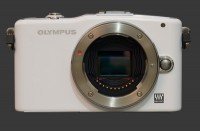
Sensor-Size: 17 x 13mm

Actual size when viewed at 100 DPI
| 12 Megapixels Mirrorless | ISO 200-12800 |
| Micro Four-Thirds Mount 2X FLM | Shutter 1/4000-60s |
| 2-Axis Built-in Stabilization | Full manual controls, including Manual Focus |
| 0.20" Optional EVF 1.4 Megapixels (0.58X) | Custom white-balance with 2 axis fine-tuning |
| Built-in Dust Reduction | Spot-Metering |
| 4.1 FPS Drive, Unlimited Images | Hot-Shoe |
| 1920x1080 @ 30 FPS Video Recording | Lithium-Ion Battery |
| 3" LCD 460K Pixels | Secure Digital Extended Capacity |
Updates
2024.04.03

Fujifilm X-T5 Review
Newest Fujifilm flagship boasting a 40 MP APS-C sensor, 5-axis IBIS with 7-stop efficiency, 15 FPS continuous drive, 6.2K Video capture, dual control-dials and dual SDXC UHS-II slots in a sturdy weatherproof and freezeproof body.
2023.11.20

Best Digital Cameras of 2023
Find out which are the Best Digital Cameras of 2023. All the new Mirrorless Digital Cameras from entry-level to high-end professional.
2023.07.10

Fujifilm X-H2 Review
40 Megapixels APS-C Hybrid Mirrorless Digital Camera with 7-stop IBIS. Fastest shutter ever and 8K video capture. Large builtin EVF with 0.8X magnification and 5.8 MP, plus an Eye-Start Sensor. Packed with features and large number of controls in a weatherproof and freezeproof body.
2023.05.07

Sony FE 20-70mm F/4G Review
Review of the unique Sony FE 20-70mm F/4G lens. The optical zoom of this lens spans ultra-wide-angle and medium focal-length coverage, making it one of the most versatile Full-Frame lenses on the market.
2023.01.15

Huion Inspiroy Dial 2 Review
Review of the Huion Inspiroy Dial 2 tablet, a medium sized drawing surface with dual dials and customizable buttons. Connects via USB-C or Bluetooth 5.0 with Windows, Linux and Android support.
2022.12.08

How to Pack for a Photo Trip
Find out how to pack for a travel photography trip, carry your gear safely while meeting airline regulations.
2022.11.13

Best Digital Cameras of 2022
The best digital cameras of 2022. A short list of the most outstanding models in their respective categories. Choose one for yourself or as a gift.
2022.09.21

Pentax DA* 60-250mm F/4 SDM Review
Review of the Pentax DA* 60-250mm F/4 SDM, the constant-aperture telephoto zoom with the highest zoom-ratio on the market.
2022.09.20

Pentax DA* 50-135mm F/2.8 SDM Review
Review of the Pentax DA* 50-135mm F/2.8 SDM, the lightest professional telephoto zoom native to the K-mount.
2022.09.10

Pentax DA* 11-18mm F/2.8 DC AW Review
Review of the Pentax DA* 11-18mm F/2.8 DC AW, the widest professional ultra-wide zoom native to the K-mount.
2021.11.24

50 Gifts Under $50 For Photographers in 2021
50 Gifts photographers will love. All for under $50 USD. 2021 Edition.
2021.11.17

Best Digital Cameras for 2021
Neocamera shows which are the very best Digital Cameras for 2021 in every category: Mirrorless, DSLR, Premium Compact, Ultra-Zoom and Rugged.













